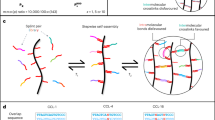Abstract
Identification of biomaterials that support appropriate cellular attachment, proliferation and gene expression patterns is critical for tissue engineering and cell therapy. Here we describe an approach for rapid, nanoliter-scale synthesis of biomaterials and characterization of their interactions with cells. We simultaneously characterize over 1,700 human embryonic stem cell–material interactions and identify a host of unexpected materials effects that offer new levels of control over human embryonic stem cell behavior.
This is a preview of subscription content, access via your institution
Access options
Subscribe to this journal
Receive 12 print issues and online access
$209.00 per year
only $17.42 per issue
Buy this article
- Purchase on Springer Link
- Instant access to full article PDF
Prices may be subject to local taxes which are calculated during checkout




Similar content being viewed by others
References
Spradling, A., Drummond-Barbosa, D. & Kai, T. Stem cells find their niche. Nature 414, 98–104 (2001).
Streuli, C. Extracellular matrix remodelling and cellular differentiation. Curr. Opin. Cell Biol. 11, 634–640 (1999).
Saltzman, W.M. in Principles of Tissue Engineering, edn. 2 (eds. Lanza, R.P., Langer, R.S. & Vacanti, J.) 221–235 (Academic Press, San Diego, 2000).
Lanza, R.P., Langer, R.S. & Vacanti, J. (eds.) Principles of Tissue Engineering, edn. 2 (Academic Press, San Diego, 2000).
Chen, R.R. & Mooney, D.J. Polymeric growth factor delivery strategies for tissue engineering. Pharm. Res. 20, 1103–1112 (2003).
Sakiyama-Elbert, S.E. & Hubbell, J.A. Functional biomaterials: Design of novel biomaterials. Annu. Rev. Mater. Res. 31, 183–201 (2001).
Fisher, J.P., Dean, D., Engel, P.S. & Mikos, A.G. Photoinitiated polymerization of biomaterials. Annu. Rev. Mater. Res. 31, 171–181 (2001).
Folkman, J. & Moscona, A. Role of cell shape in growth control. Nature 273, 345–349 (1978).
Moll, R., Franke, W.W., Schiller, D.L., Geiger, B. & Krepler, R. The catalog of human cytokeratins: patterns of expression in normal epithelia, tumors and cultured cells. Cell 31, 11–24 (1982).
Abraham, V.C., Taylor, D.L. & Haskins, J.R. High content screening applied to large-scale cell biology. Trends Biotechnol. 22, 15–22 (2004).
Burkoth, A.K., Burdick, J. & Anseth, K.S. Surface and bulk modifications to photocrosslinked polyanhydrides to control degradation behavior. J. Biomed. Mater. Res. 51, 352–359 (2000).
Hern, D.L. & Hubbell, J.A. Incorporation of adhesion peptides into nonadhesive hydrogels useful for tissue resurfacing. J. Biomed. Mater. Res. 39, 266–276 (1998).
MacBeath, G., Koehler, A.N. & Schreiber, S.L. Printing small molecules as microarrays and detecting protein-ligand interactions en masse. J. Am. Chem. Soc. 121, 7967–7968 (1999).
MacBeath, G. & Schreiber, S.L. Printing proteins as microarrays for high-throughput function determination. Science 289, 1760–1763 (2000).
Schena, M., Shalon, D., Davis, R.W. & Brown, P.O. Quantitative monitoring of gene-expression patterns with a complementary-DNA microarray. Science 270, 467–470 (1995).
Thomson, J.A. et al. Embryonic stem cell lines derived from human blastocysts. Science 282, 1145–1147 (1998).
Levenberg, S., Golub, J.S., Amit, M., Itskovitz-Eldor, J. & Langer, R. Endothelial cells derived from human embryonic stem cells. Proc. Natl. Acad. Sci. USA 99, 4391–4396 (2002).
Yaffe, D. & Saxel, O. Serial passaging and differentiation of myogenic cells isolated from dystrophic mouse muscle. Nature 270, 725–727 (1977).
Levenberg, S. et al. Differentiation of human embryonic stem cells on three-dimensional polymer scaffolds. Proc. Natl. Acad. Sci. USA 100, 12741–12746 (2003).
Acknowledgements
The authors would like to thank David Putnam, David Lynn, David Lavan and Daniel Kohane for helpful advice, Mara Macdonald for help with cell culture and Joseph Itskovitz-Eldor for assistance and cooperation in conducting this research. We would also like to thank Sean Milton and the BioMicro Center for help with slide analysis. This work was supported by the National Science Foundation (through the MIT Biotechnology Process and Engineering Center) and the National Institutes of Health (grant no. HL60435).
Author information
Authors and Affiliations
Corresponding author
Ethics declarations
Competing interests
The authors declare no competing financial interests.
Supplementary information
Supplementary Fig. 1
C2C12 cells grown on polymer arrays. (PDF 104 kb)
Supplementary Fig. 2
Design of “hit” Polymer arrays (PDF 214 kb)
Supplementary Fig. 3
Standard deviation of Cell coverage on Different Materials (PDF 118 kb)
Supplementary Fig. 4
Cells per spot with RA, on day one (PDF 82 kb)
Supplementary Fig. 5
Cells per spot with RA, on day six (PDF 81 kb)
Supplementary Table 1
Percent cells cytokeratin 7 positive on different materials over time (PDF 26 kb)
Rights and permissions
About this article
Cite this article
Anderson, D., Levenberg, S. & Langer, R. Nanoliter-scale synthesis of arrayed biomaterials and application to human embryonic stem cells. Nat Biotechnol 22, 863–866 (2004). https://doi.org/10.1038/nbt981
Received:
Accepted:
Published:
Issue Date:
DOI: https://doi.org/10.1038/nbt981
This article is cited by
-
Towards organoid culture without Matrigel
Communications Biology (2021)
-
Materials control of the epigenetics underlying cell plasticity
Nature Reviews Materials (2020)
-
Extracellular matrix-based materials for regenerative medicine
Nature Reviews Materials (2018)
-
Why the impact of mechanical stimuli on stem cells remains a challenge
Cellular and Molecular Life Sciences (2018)
-
Fabrication of sulphonated poly(ethylene glycol)-diacrylate hydrogel as a bone grafting scaffold
Journal of Materials Science: Materials in Medicine (2018)



